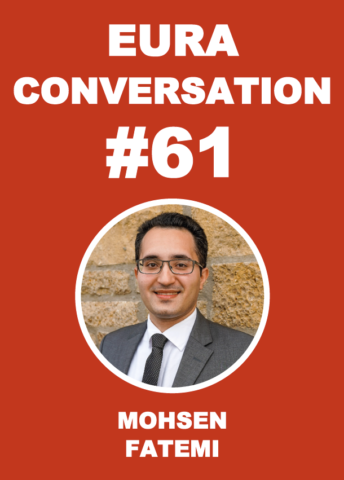
#60 Cities on the edge
28/02/2024
Urban Regeneration Talk #3, Ireland
28/03/2024Conversation #61
Integrating Social Equity into Electric Utility Planning
by Mohsen Fatemi
University of Kansas, USA
Energy is a key driver of life in the city. Everything from leisure to livelihoods in the city is made possible by energy sources that light up city streets, connect people through transportation systems, and keep food fresh in refrigeration systems depend on reliable and robust energy supply, as millions of Texans experienced during 2021 blackout (Buchele, 2023). At the same time, as many scholars and practitioners point out: urban energy use contributes dangerously to climate change. This point was already underlined in a recent conversation arguing for a 3D (decarbonization, digitalization, and decentralization) to urban energy policy. However, the story does not end here. Over the past fifteen years, I have dedicated a significant part of my academic journey to exploring various facets and scales of energy. Here I examine urban energy using diverse lenses from architecture, urban planning, and public administration to provide a multi-faceted perspective on the energy sector, and to argue for a broader vision of the future of energy, which transcends the prevalent discourse on energy transition as a climate change mitigation strategy and a global imperative to protect our planet (IPCC, 2023). While it is clear that we must continue to provide strong support efforts to combat climate change, I argue that the energy planning discourse, often dominated by its technical aspects, overlooks the importance of integrating social equity into utility planning by urban policymakers as they devise long-term strategies.
The varied experiences that I have had have illuminated the critical role of utility planning in the energy sector's broader context, yet it remains under-explored by scholars focusing on social equity. Questions of energy poverty have long been tackled in the literature (Bednar & Reames, 2020; Sovacool, 2012), sparking debates about just transitions (Carley & Konisky,2020), but cities tend to be neglected in these conversations. As an architect, I encountered resistance to implementing energy conservation measures in building designs, due to cost concerns or developers' profit motives. My urban planning studies introduced me to utility energy efficiency programs, which, regrettably, often disproportionately benefit affluent consumers, leaving a heavier burden on others. This underscores a broader issue of service provision bias, which utilities, especially investor-owned ones, exacerbate by cloaking their planning efforts in technical complexity, thus stifling public engagement and critique.
For instance, while serving on the Sustainability Advisory Board in Lawrence, Kansas, I found it challenging to grasp the details of an integrated resource plan presented by our local investor-owned utility (IOU), which limited my ability to contribute meaningfully to the discussion. Similarly, during a presentation in Wichita, Kansas, the public's engagement was stymied by the utility's complex and convoluted responses, which effectively silencing dissent or inquiry . Consequently, Lawrence reluctantly acquiesced to the IOU's plan to extend the operation of their coal-fired power plant for several more years, contradicting earlier commitments to its closure. Interestingly, when a board member directly questioned IOU representatives about their concern for the mortality rates linked to coal power plants, the reply was a deflective reference to adherence to regulations, suggesting that questions regarding environmental impact should be directed at the Environmental Protection Agency instead . Likewise, in Wichita, public hearings barely influenced the IOU’s decisions on rate setting. Power imbalances are heavily discussed (Stokes, 2020) in the discourse around energy democracy, and discourses need to find their way to policy discussions around utility planning.
The past decade's advancement in energy justice frameworks (Sovakool & Dworkin, 2015; Jenkins et al., 2016) offers valuable tools for incorporating social equity principles into utility planning, presenting an opportunity to alter power dynamics within the energy sector (Stephens, 2019) amid the pressing challenges of climate change and sectoral transformation. Within a landscape of substantial investments in U.S. energy infrastructure, propelled by initiatives like the Inflation Reduction Act and the Infrastructure Investment and Jobs Act in the U.S., along with comparable policies in Europe, such as Germany's Renewable Energy Act, it is crucial to capitalize on this unique chance for change before this window of opportunity closes, and we are compelled to await future opportunities.
Motivated by this conviction, I am taking a step by joining the energy justice movement and centering the work in my doctoral dissertation at the University of Kansas’s School of Public Affairs and Administration around it. Inequality is on the rise, and it is having an impact on urban settlements. Utility planning can alleviate or compound this issue. It is important to mainstream social equity into utility resource planning processes, and to identify conditions that facilitate this integration. This is an area of potentially fruitful exchange, learning, and knowledge co-production between researchers based in Europe and in North America. Questions that I want to spark conversations around are:
- Overcoming Resistance Strategies: How can urban and social equity researchers develop and advocate for strategies that effectively counter resistance from and obstruction by investor-owned utilities against incorporating social equity considerations into their planning processes?
- Public Engagement Enhancement: In what ways can we expand and deepen public engagement in utility planning processes to ensure inclusivity and representation of marginalized communities' voices? What models or frameworks can facilitate this enhanced engagement?
- Case Studies of Successful Integration: Which jurisdictions or contexts have successfully integrated social equity into utility resource planning, and what can be learned from these examples? How can these success stories be replicated or adapted in different settings?
- Operationalizing Energy Justice Frameworks: How can energy justice frameworks be effectively operationalized within the utility planning process to reshape power dynamics and promote equity? What challenges and opportunities do these frameworks present for utility planning and policy-making?
- Impact of Legislative Actions on Social Equity: What implications do recent legislative actions (e.g. the Inflation Reduction Act and the Infrastructure Investment and Jobs Act in the U.S.) have for integrating social equity into energy planning? How can researchers and practitioners leverage these legislative frameworks to advance social equity in utility planning?
References:
Bednar, D. J., & Reames, T. G. (2020). Recognition of and response to energy poverty in the United States. Nature Energy, 5(6), 432-439.
Buchele, M. (2023, February 17). Two years later, the 2021 blackout still shapes what it means to live in Texas. NPR.
Carley, S., & Konisky, D. M. (2020). The justice and equity implications of the clean energy transition. Nature Energy, 5(8), 569-577.
Intergovernmental Panel on Climate Change. (2023). Climate Change 2023: Synthesis Report. IPCC.
Jenkins, K., McCauley, D., Heffron, R., Stephan, H., & Rehner, R. (2016). Energy justice: A conceptual review. Energy Research & Social Science, 11, 174-182.
Sovacool, B. K. (2012). The political economy of energy poverty: A review of key challenges. Energy for Sustainable Development, 16(3), 272-282.
Sovacool, B. K., & Dworkin, M. H. (2015). Energy justice: Conceptual insights and practical applications Applied energy, 142, 435-444.
Stephens, J. C. (2019). Energy democracy: Redistributing power to the people through renewable transformation. Environment: Science and Policy for Sustainable Development, 61(2), 4-13.
Stokes, L. C. (2020). Short circuiting policy: Interest groups and the battle over clean energy and climate policy in the American States. Oxford University Press, USA.








Thank you for this insightful and adequate reflection on the need for integrating social equity into electric utility planning. It is really nice how you emphasize the urban perspective in this regard, in which, to my opinion, you rightfully state that ‘cities tend to be neglected’ in conversations on just transitions.
As a scholar and practitioner, I work on stakeholder- and community involvement in the energy transition, and more specifically in the expansion of the national electricity grid in the Netherlands.
The expansion of the grid is crucial for the energy transition (replacement of fossil fuels by renewable energy leads to a large burden on the net), but it has a major spatial impact on citizens’ living environment.
While public participation is well-organized in the Netherlands and citizens are invited to participate and think along with implementation of the energy transition and infrastructure, it remains difficult to provide an equal playing field for all stakeholders.
Debates on this center mostly on how to involve citizens as a serious partner in implementation processes of renewable energy projects and infrastructure, but there is little attention on inclusion and social equity in this regard.
I agree with you that the energy transition provides opportunities for changing the traditional power imbalance into a more equal and just balance of powers, which we should take advantage of. And also that if we don’t design this process in an inclusive way, inequality is on the rise. It is promising that scholars like